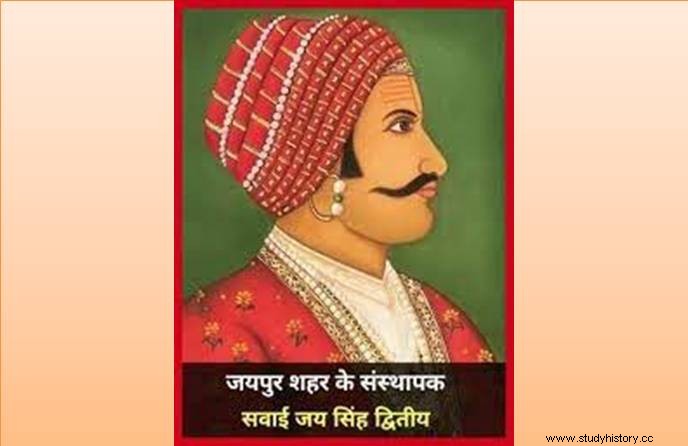
In the early period, there were three kings named Dhundhar, Amber in the intermediate period and Jai Singh in the Jaipur state, which was named as Jaipur state in the later period. Jai Singh (I) was the king of Amer from 1621 to 1668 AD. He served three Mughal emperors – Jahangir (1605–1627 AD), Shah Jahan (1627–1658 AD) and Aurangzeb (1658–1707 AD). In 1636 AD, Shah Jahan gave him the title of Mirza Raja. That is why he became famous in the history of India as Mirza Raja Jai Singh.
Jai Singh (II) became the king of Amer from 1700 to 1743 AD. He played an important role in the politics of North India during the time of four Mughal emperors namely Aurangzeb, Bahadur Shah, Farrukhsiyar and Muhammad Shah.
Jai Singh (III) was the king of Jaipur from 25 April 1819 to 6 February 1835. His father died a few months before his birth. As soon as he opened his eyes in this world, he became the king of Jaipur and died at the age of only 14. During his reign, the state of Jaipur was governed under the Treaty of Subordinate Cooperation with the East India Company.
The present book is centered on Sawai Raja Jai Singh (II). Sawai Raja Jai Singh became the most famous, admired, intelligent, visionary and influential king among the kings of North India in the first half of the eighteenth century. He was the most prominent among the great kings of the vast Amber princely state located in the region of Dhoondhad. In the eighteenth century India's politics was hesitating, to bear the brunt of the severe conditions and to save the princely state from falling into the hands of the Mughals, Marathas or Jats, it was the job of a big-hearted king like Jai Singh.
When Sawai Jai Singh opened his eyes, the state of Amber was at the peak of its poverty, being a victim of the diplomacy of the Mughal emperors. Aurangzeb's dangerous intentions were to completely destroy all the Hindu princely states like Jodhpur, Jaipur, Bikaner, Mewar etc. He also wanted to swallow up the Sikhs of Punjab, the Marathas of the south and the Shia kingdoms of the far south. Every king who was not a Sunni and every person who was not a Sunni was an enemy of Aurangzeb. To say that Aurangzeb kept fighting throughout his life to eradicate kufr, but he was also thirsty for the blood of his own children who were Sunni like him because of being his child. Due to this the bloody game of Aurangzeb was flowing rivers of blood all over India.
Aurangzeb made many plans to deal with Sawai Jai Singh in his childhood. In 1696 AD, when Prince Jai Singh was only eight years old, he was presented to Aurangzeb for the first time. Aurangzeb instructed Jai Singh's father Bishan Singh to immediately submit Jai Singh to the royal service. At the tender age of ten years, Jai Singh had to appear on the southern front. Two years later, Jaisingh had to take over the rule of the vast princely state of Amber at the age of only 12, due to his father's shadow getting up from his head. For a long period of 43 years, this great king had to face not only the intrigues of the Mughal court, the raids of the Maratha chieftains, the intentions of the Jat leaders and the betrayals of the neighboring Rajput princely states, but also for the protection of Hindu subjects, culture and science. Huge money, time and resources also had to be raised.
Sawai Raja Jai Singh (II) was rich in weapons and scriptures. Praja was Vatsal, he was the one to give fearlessness to the refugee. He was a devotee of Lord Vishnu and was initiated into the Nimbarka sect. Forced by circumstances, he had to fight wars, but he was not a messenger of wars, but a messenger of peace. Perhaps Aurangzeb had seen this versatility in him when Jaisingh was only eight years old. That is why Aurangzeb instructed him to be sent to the war front at the age of eight so that Kufr could be eradicated in his childhood, but Jai Singh survived and served the land of India for a long time.
This book is a humble tribute to the same great king Sawai Jai Singh on whose footsteps Indian society is still running and moving forward. Hope the readers will like this book. Shubham.
-Doctor. Mohanlal Gupta
63, SardarClub Yojna
Air Force Area, Jodhpur
